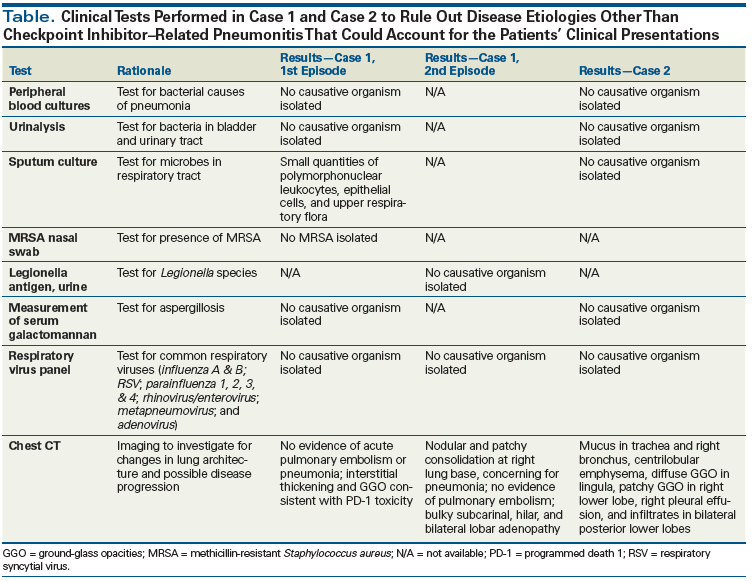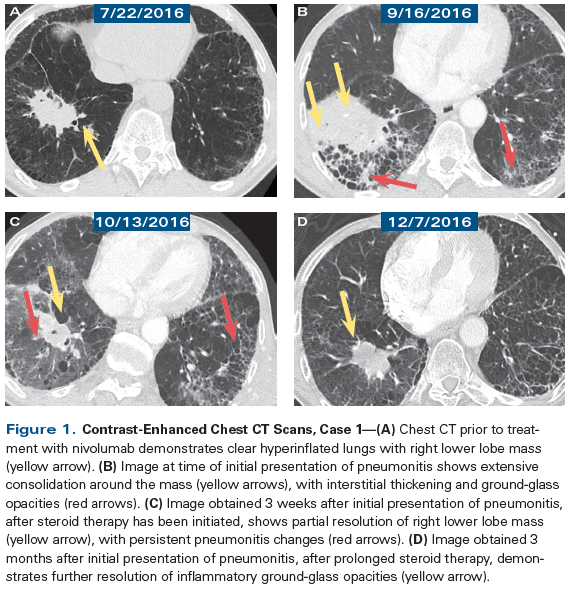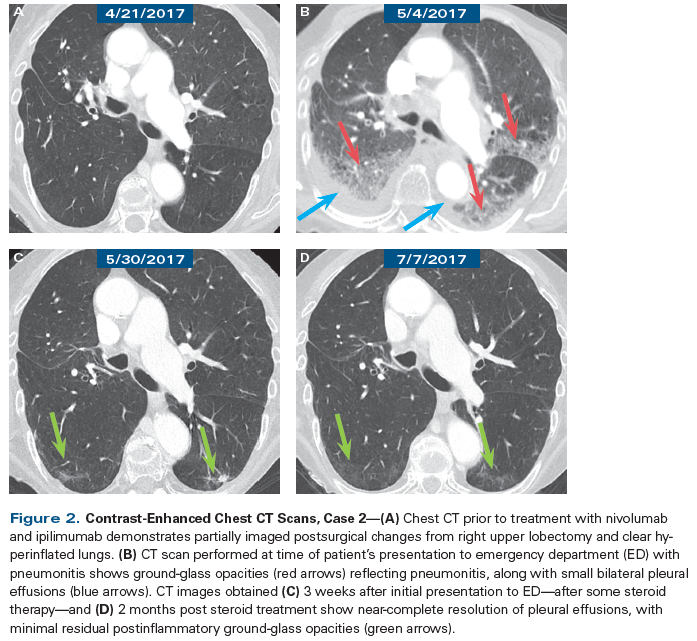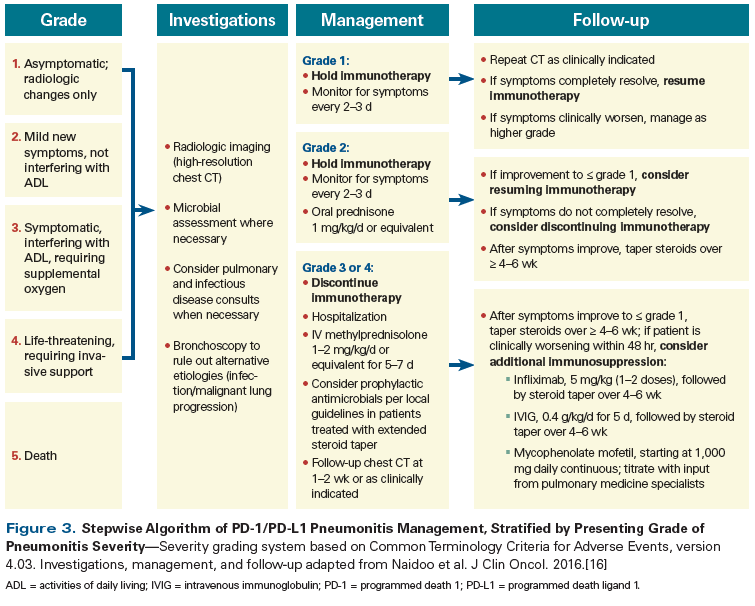Pneumonitis is defined as a focal or diffuse inflammation of the lung parenchyma, and is a known, potentially fatal toxicity of anti–programmed death 1 (PD-1)/programmed death ligand 1 (PD-L1) immune checkpoint inhibitors. Herein we discuss two patients who developed pneumonitis secondary to anti–PD-1/PD-L1 immune checkpoint inhibitor therapy and illustrate a stepwise approach to the diagnostic evaluation and management of anti–PD-1/PD-L1–related pneumonitis. In the majority of patients who develop this toxicity, pneumonitis appears to clinically resolve with corticosteroid therapy alone; however, a subset of patients require additional immunosuppressive medications. Patients who clinically improve with steroid treatment must be monitored closely in the outpatient setting. If pneumonitis management results in complete clinical and radiologic resolution, patients may be able to restart their immune checkpoint inhibitor therapy. It is currently unclear which population of patients is more susceptible to developing higher-grade or steroid-refractory pneumonitis.
Introduction
Immune checkpoint molecules serve as a system of checks and balances to limit immunologic activity against self-antigens.[1] In a patient with cancer, tumor cells can hijack the expression of immune checkpoint molecules to evade immunologic destruction.[1] Immune checkpoint inhibitors are a class of anticancer agents that have been used as a therapeutic strategy in a variety of solid tumors and hematologic malignancies to counteract the effects of immune checkpoint molecules. By inhibiting the ability of tumor-induced checkpoint molecule expression to deactivate immune cells, immune checkpoint inhibitors reinvigorate an antitumor immune response.[2] In clinical practice, immune checkpoint inhibitors that block the activity of the programmed death 1 (PD-1) molecule (nivolumab, pembrolizumab, avelumab) and its ligand, programmed death ligand 1 (PD-L1; atezolizumab, durvalumab) are now approved by the US Food and Drug Administration for multiple solid tumors and hematologic malignancies, based on improvements in survival outcomes and tumor response in cancers such as melanoma,[3] non–small-cell lung cancer (NSCLC),[4,5] renal cell carcinoma,[6] urothelial carcinoma,[7] head and neck cancer,[8] Merkel cell carcinoma,[9] microsatellite-unstable cancers,[10] and Hodgkin lymphoma.[11,12]
Although clearly efficacious, immune checkpoint inhibitors are associated with the development of certain adverse events, termed immune-related adverse events (irAEs), that occur as a result of inflammation in nontarget areas of the body. Of these irAEs, pneumonitis is an uncommon but potentially fatal toxicity of anti–PD-1/PD-L1 immune checkpoint inhibitors.[13]
Pneumonitis is defined as a focal or diffuse inflammation of the lung parenchyma.[14] The grading system used for pneumonitis is based on criteria listed in the Common Terminology Criteria for Adverse Events (CTCAE; version 4.03).[15] Patients with pneumonitis secondary to PD-1/PD-L1 immune checkpoint inhibitors may present clinically with dyspnea, cough, fever, and chest pain; or patients may be asymptomatic, with radiologic findings alone.[16] The mechanism of development of pneumonitis secondary to anti–PD1/PD-L1 immune checkpoint inhibitors is unknown. The incidence rate of pneumonitis in advanced solid cancers and melanoma following anti–PD-1/PD-L1 immune checkpoint inhibitor therapy is estimated at 5%.[16] This estimate was confirmed in a meta-analysis of patients diagnosed with NSCLC and treated with anti–PD-1 immune checkpoint inhibitors, where the incidence rate for all grades of pneumonitis was 4.1%, that for grade 3+ events was 1.8%, and the rate of pneumonitis-related deaths was 0.4%.[17] Combination immune checkpoint inhibitor therapy utilizing anti–PD-1/PD-L1 and anti–cytotoxic T-lymphocyte–associated protein 4 (CTLA-4) agents is associated with a higher incidence of pneumonitis, with shorter time to onset, compared with anti–PD-1/PD-L1 monotherapy.[16] Additionally, the incidence rate of pneumonitis is reported to be higher in patients treated with anti–PD-1/PD-L1 immune checkpoint inhibitors than in those treated with anti–CTLA-4 agents.[18] While the incidence of irAEs is relatively low, the absolute number of patients receiving immune checkpoint inhibitors is steadily increasing. Thus, it is likely that, with time, larger numbers of patients will develop irAEs, including pneumonitis.
Case #1
A 73-year-old man with a 30 pack-year history of cigarette smoking and stage IV NSCLC was treated with 6 cycles of first-line carboplatin/nab-paclitaxel combination chemotherapy (Figure 1A). He then developed progressive NSCLC, and commenced second-line, standard-of-care nivolumab (3 mg/kg). After 2 cycles of nivolumab, the patient presented to the outpatient oncology clinic with a new dry cough, shortness of breath, and dyspnea on exertion, but was noted to have normal oxygen saturation on room air. A contrast-enhanced CT scan of the chest performed the same day demonstrated new peribronchial nodularity in the right lower lobe and a mild increase in size of the primary right lower lobe mass (Figure 1B). At that time, it was thought likely that the patient’s acute presentation was due to anti–PD-1–induced pneumonitis, of grade 2 severity. A pan-culture performed at that time (sputum, blood, and urine cultures) did not reveal any causative organisms, and the patient declined a suggested bronchoscopy (Table). He was thus started on a 7-day course of oral prednisone at a dose of 1 mg/kg (50 mg daily) and nivolumab therapy was held. A week later, the patient noted near-complete resolution of his symptoms. He then began a prednisone taper over 4 weeks, starting at 50 mg/daily, with the dose reduced by 10 mg per week over 4 weeks. He returned to the outpatient clinic 2 weeks later with a reported recrudescence of symptoms. A slower prednisone taper was prescribed, starting with 20 mg/daily, and reducing the dose by 5 mg every 2 weeks for 8 weeks-and nivolumab was permanently discontinued. A repeat CT scan at this time demonstrated progressive disease, and systemic chemotherapy was commenced. Two weeks later, he presented to the emergency department with dyspnea on exertion and a worsening, nonproductive cough, and was admitted to the medical intensive care unit for likely progressive NSCLC and possible persistent pneumonitis.
The patient received a high dose of prednisone (2 mg/kg) and was managed with 6 L of supplemental oxygen via nasal cannula. He began to desaturate (80% oxygen saturation) with movement, and was treated with ipratropium bromide/albuterol nebulizers twice daily. A bronchoscopy was not performed upon admission as the patient was not stable enough to undergo the procedure. A pan-culture was performed at this time (sputum, peripheral blood, and methicillin-resistant Staphylococcus aureus surveillance culture; see Table); results did not reveal a causative microbial organism. The patient’s symptoms improved once again after 48 hours of high-dose corticosteroids and oxygen supplementation; thus, while additional immunosuppression had been considered, it was not administered at that time. A course of trimethoprim/sulfamethoxazole was started as prophylaxis for Pneumocystis jirovecii pneumonia. The patient was successfully discharged on a 1.5-mg/kg dose of prednisone (45 mg/daily) and was held at that dosage for 4 weeks, with plans to evaluate the duration of the steroid taper at the next outpatient appointment in 1 month’s time. At the 1-month follow-up visit, the patient was readmitted for worsening dyspnea. Follow-up chest CT scan demonstrated progression of NSCLC, with enlarging mediastinal and hilar adenopathy despite improved changes from prior pneumonitis (Figures 1C and 1D). He was subsequently discharged to inpatient palliative care services and died 2 weeks later.
Case #2
A 70-year-old woman with a 50 pack-year history of cigarette smoking and recurrent small-cell lung cancer (SCLC) was treated with a right upper lobectomy for stage I resectable SCLC, followed by 4 cycles of adjuvant carboplatin/etoposide chemotherapy (Figure 2A). Three months after completion of chemotherapy, the patient developed progressive SCLC with new bony metastases, as well as a right adrenal metastasis. Second-line, standard-of-care nivolumab (1 mg/kg) and ipilimumab (3 mg/kg) was started. Three days after receiving her first cycle of therapy, the patient experienced new-onset fever, fatigue, generalized weakness, and nausea, which were managed supportively. One week later, she presented to her local emergency department with a 1-day history of acute onset shortness of breath. At that time, she was found to be hypoxic on room air (oxygen saturation, 80%). Her diagnostic evaluation included a CT scan of the chest without contrast (Figure 2B), which revealed new patchy ground-glass opacities in the right lower lobe and small bilateral pleural effusions. Blood cultures and a respiratory virus panel were ordered, neither of which revealed a causative microbial organism (Table). Due to the patient’s hypoxia, she was not deemed suitable for bronchoscopy on admission. Her clinical presentation was thus thought to be consistent with anti–PD-1–related pneumonitis, of grade 3 severity.
The patient was started on intravenous prednisone (100 mg; 2mg/kg) and high-flow oxygen to maintain oxygen saturation > 92%. She reported symptomatic improvement within 48 hours and was discharged 4 days later with supplemental oxygen and a 4-week taper of prednisone; the initial prednisone dose was 40 mg daily, which was to be reduced by 10 mg per week. Following 2 weeks of corticosteroid treatment, she presented for outpatient follow-up with her oncologist and demonstrated both clinical and radiologic improvement (Figure 2C). Her oxygen saturation was > 93% on room air at that time, and also at a subsequent visit 2 weeks later. A follow-up CT scan performed 9 weeks after the initial presentation of pneumonitis (Figure 2D) demonstrated almost complete resolution of the ground-glass opacities and resolution of the pleural effusions. Unfortunately, near the completion of the prednisone taper, the patient experienced another episode of dyspnea, and, after discussion with the pulmonary medicine service, prednisone was increased to 20 mg daily, with a slower taper of 5 mg per week to allow for a 4-week taper, which successfully alleviated her symptoms. Ipilimumab and nivolumab were permanently discontinued, and the patient’s next line of systemic therapy for SCLC was begun after a subsequent CT scan demonstrated progressive disease in the adrenal glands and a new liver lesion.
Discussion
These two cases describe the clinical presentation, diagnostic evaluation, management, and outcomes of two patients who developed anti–PD-1–related pneumonitis: one patient with NSCLC who received single-agent anti–PD-1 therapy, and a second patient with small-cell lung cancer treated with an anti–CTLA-4/PD-1 combination immune checkpoint inhibitor regimen.
These cases illustrate that there are both diagnostic and therapeutic challenges in identifying and managing patients who develop suspected anti–PD-1/PD-L1–related pneumonitis. The differential diagnosis for pneumonitis is wide, and drug-induced pneumonitis is a diagnosis of exclusion. Thus, in a patient in whom pneumonitis is suspected, providers must also consider competing causes for the clinical presentation, such as lung infection and/or progressive metastatic disease in the lung. Therapeutically, because pneumonitis may result in rapid patient decompensation, providers may elect to begin management with both antibiotics and corticosteroids before diagnostic tests are complete. The work-up often includes an extensive infection workup, high-resolution CT scan of the chest, and, for CTCAE grade 2 or higher presentations of pneumonitis, a bronchoscopic examination to rule out infection or disease progression. In the largest reported series of patients with anti–PD-1/PD-L1–related pneumonitis from two large academic centers, radiologic features on CT scan were categorized as cryptogenic organizing pneumonia–like (19%), resembling hypersensitivity pneumonitis (22%), discrete focal ground glass opacities (37%), or interstitial changes (7%). Fifteen percent of patients had a constellation of these findings, and were categorized radiologically as having pneumonitis not otherwise specified.[17] Of note, although rare, anti–PD-1 therapy–related myocarditis can present with fulminant heart failure that may radiographically mimic pneumonitis; the presence of arrhythmias, chest pain, or evidence of volume overload on examination should prompt a cardiology evaluation.
KEY POINTS
- Following a stepwise approach will help physicians arrive at a reliable diagnosis and treatment plan for suspected anti–PD-1/PD-L1–related pneumonitis. In symptomatic patients, an extensive infection workup, radiologic imaging with a chest CT scan, and bronchoscopy should be strongly considered.
- Restarting immune checkpoint inhibitors can be considered if the pneumonitis initially presents as ≤ grade 2, and within a few days of initiation of pneumonitis management is downgraded to ≤ grade 1, without recrudescence of symptoms after corticosteroid taper.
- In the future, it will be critical to understand the mechanistic underpinnings of anti–PD-1/PD-L1–related pneumonitis, in order to tailor management approaches.
After the diagnosis of pneumonitis has been made, this toxicity must be graded and treated based on the CTCAE-defined grade. Broadly, grade 1 pneumonitis can be treated by withholding immune checkpoint inhibitors and by careful clinical observation. It has been advised that the immune checkpoint inhibitor regimen not be restarted until CT scans show improvement or there is complete resolution of pneumonitis. Patients with grade 2 pneumonitis (symptomatic pneumonitis) should receive prednisone, 0.5–1 mg/kg/d, or the equivalent, and patients with grade 3 pneumonitis should receive a higher dose: 1–2 mg/kg or the equivalent. If there is clinical improvement within a few days of implementation of this course of management, a 4- to 6-week corticosteroid taper may be completed. If the patient does not clinically improve within approximately 2 to 7 days of the start of corticosteroid administration, additional immunosuppressive medications may be considered (infliximab, cyclophosphamide, or mycophenolate mofetil); however, outcomes of these therapies have been variable in reported series.[13] In addition, administration of an interferon gamma release assay for tuberculosis and additional considerations may be prudent before initiation of treatment with these agents. In patients who develop a recrudescence of symptoms during or after steroid tapering, an underlying infectious etiology, such as Pneumocystis jirovecii or bacterial pneumonia, should be considered, or a repeat clinical/radiologic evaluation for recurrent pneumonitis should be performed. In selected cases, when corticosteroids are restarted or given over an extended taper, antimicrobial prophylaxis should be considered in accordance with local practices. Finally, after the acute treatment phase, along with CT imaging, pulmonary function tests (including carbon monoxide diffusion [DLCO] and spirometry) may be useful in tracking the response of the pneumonitis to immunosuppressive management. A diagnostic evaluation and management algorithm based on clinical practice and published literature[16,19-21] for anti–PD-1/PD-L1–related pneumonitis has been included in this article (Figure 3).
In considering these two cases, the patient in Case 1 was diagnosed quickly and managed effectively with corticosteroids at his initial presentation; however, symptoms re-emerged, and subsequent treatment with corticosteroids was less effective. In addition, the patient developed progressive disease, which ultimately was the cause of death. This case highlights the diagnostic complexity of identifying anti–PD-1/PD-L1–related pneumonitis in patients with NSCLC, as well as the fact that pneumonitis may occur concurrently with disease progression. Further, it was not possible to perform bronchoscopy in this patient to truly rule out infection in the lung, which may have further complicated this clinical presentation and management.
In Case 2, the patient’s pneumonitis was highly steroid-responsive, but as in Case 1, a re-emergence of symptoms was seen after a 4-week steroid taper, warranting a slower taper. In both cases, the patients were followed closely and re-emergence of symptoms was treated expeditiously, with repeat evaluation for infection or other causes. After discharge, the patients were also followed closely in the outpatient setting. The patient in Case 1 was treated with antimicrobial prophylaxis after receiving an extended course of corticosteroids. Neither patient was treated with additional immunosuppression beyond corticosteroids, since both demonstrated improvement shortly after initiation of steroid therapy; however, given the recurrent nature of the first patient’s pneumonitis, it is unclear whether he might have benefited from additional immunosuppression at some stage during his steroid therapy, and if so, when this might have ideally been instituted. In addition to these clinical observations, our cases highlight the variability in radiologic findings in patients with anti–PD-1/PD-L1–related pneumonitis, as depicted in Figures 1 and 2.
Outpatient monitoring is also essential to improving the chances of recognizing pneumonitis early. Before starting immune checkpoint inhibitors, baseline radiologic imaging with high-resolution chest CT (with and without contrast) should be performed. It is critical that patients be made aware of the possible signs and symptoms of pneumonitis to report to their providers, including new or worsening dyspnea on exertion, shortness of breath, cough, chest pain, and fever.[22] Patients with confirmed pneumonitis should be followed with regular CT imaging of the chest, at least every 1 to 2 weeks in severe cases, until they improve or resolve to ≤ grade 1, and thereafter as clinically indicated. Pulmonary function tests may be useful in this population of patients, and pulse oximetry, both at rest and on exertion, as well as spirometry and DLCO may be considered.[22] Patients who may be eager to restart immune checkpoint inhibitor therapy after recovering from pneumonitis. However, restarting immune checkpoint inhibitors should be considered cautiously, particularly if they presented with pneumonitis of CTCAE severity ≥ grade 2. In a series of patients published by Naidoo and colleagues, among patients who presented with grade 2 or milder pneumonitis and who were re-challenged with immune checkpoint inhibitors, 25% developed recurrent pneumonitis.[16] Careful deliberation is necessary when restarting immune checkpoint inhibitors in patients who present with pneumonitis of severity ≥ grade 3, as there are few published data to guide clinicians.
These two cases do not highlight certain clinical features that are important in diagnosing anti–PD-1/PD-L1–related pneumonitis. Notably, the timing of anti–PD-1/PD-L1–related pneumonitis onset may vary widely.[16] The patients in both Case 1 and Case 2 developed pneumonitis shortly after the start of therapy; however, pneumonitis has been reported to have occurred more than a year after the first dose of immune checkpoint inhibitor therapy. The incidence rate of pneumonitis across cancer types appears to vary; however, new data suggest that the incidence of pneumonitis in lung cancer patients may be higher than in other cancers.[17] Highlighted in Figure 3 are possible immunosuppressive treatments for steroid-refractory pneumonitis. Steroid-refractory pneumonitis is extremely rare: in the previously reported series of patients who received anti-PD-1/PD-L1 immune checkpoint inhibitors at two large academic centers, the incidence rate of pneumonitis was 5% (N = 43), and of the affected patients, only 11.6% required additional immunosuppression.[16] In this study, patients who received further immunosuppressive treatment did not recover from their pneumonitis, and this group included those treated with infliximab, cyclophosphamide, and mycophenolate mofetil. The foregoing immunosuppressive therapies, as well as intravenous immunoglobulin (IVIG), have been used successfully to manage other irAEs, such as colitis and neurologic toxicities. It is postulated that IVIG may be a useful treatment for pneumonitis, since it may not be associated with the same rate of infective complications as other immunosuppressive medications. Mycophenolate mofetil has previously been used for the treatment of interstitial lung diseases.[23] Currently, there are few published data to guide clinicians regarding the selection and dosing of immunosuppressive agents for steroid-refractory pneumonitis; however, prospective studies are planned.
As more patients receive immune checkpoint inhibitors, oncologists will need to become adept at identifying and managing the side effects of these agents, through experience and education. To facilitate this, the National Comprehensive Cancer Network (NCCN) has created an “Immunotherapy Teaching/Monitoring Tool” to help physicians learn more about immune checkpoint inhibitors and track their patients’ symptoms; also, an upcoming joint NCCN/American Society of Clinical Oncology panel is developing guidelines on immune-related toxicities.[24] Future research aimed at identifying potential biomarkers for clinically important immune-related toxicities, such as pneumonitis, is needed.
Financial Disclosure: The authors have no significant financial interest in or other relationship with the manufacturer of any product or provider of any service mentioned in this article.
References:
1. Schreiber RD, Old LJ, Smyth MJ. Cancer immunoediting: integrating immunity’s roles in cancer suppression and promotion. Science. 2011;25:1565-70.
2. Naidoo J, Page D, Wolchok J. Immune checkpoint blockade. Hematol Oncol Clin N Am. 2014;28:585-600.
3. Larkin J, Chiarion-Sileni V, Gonzalez R, et al. Combined nivolumab and ipilimumab or monotherapy in untreated melanoma. N Engl J Med. 2015;373:23-34.
4. Kazandjian D, Suzman DL, Blumenthal G, et al. FDA approval summary: nivolumab for the treatment of metastatic non-small cell lung cancer with progression on or after platinum-based chemotherapy. Oncologist. 2016;21:634-42.
5. Langer CJ, Gadgeel SM, Borghaei H, et al. Carboplatin and pemetrexed with or without pembrolizumab for advanced, non-squamous non-small-cell lung cancer: a randomized, phase 2 cohort of the open-label KEYNOTE-021 study. Lancet Oncol. 2016;17:1497-1508.
6. Cella D, Grünwald V, Nathan P, et al. Quality of life in patients with advanced renal cell carcinoma given nivolumab versus everolimus in CheckMate 025: a randomized, open-label, phase 3 trial. Lancet Oncol. 2016;17:994-1003.
7. Bellmunt J, de Wit R, Vaughn DJ, et al. Pembrolizumab as second-line therapy for advanced urothelial carcinoma. N Engl J Med. 2017;376:1015-26.
8. Ferris RL, Blumenschein G, Fayette J, et al. Nivolumab for recurrent squamous-cell carcinoma of the head and neck. N Engl J Med. 2016;375:1856-67.
9. Kaufman H, Russell J, Hamid O, et al. Avelumab in patients with chemotherapy-refractory metastatic Merkel cell carcinoma: a multicenter, single-group, open-label, phase 2 trial. Lancet Oncol. 2016;17:1374-85.
10. Le DT, Uram JN, Wang H, et al. PD-1 blockade in tumors with mismatch-repair deficiency. N Engl J Med. 2015;372:2509-20.
11. Raval R, Sharabi A, Walker A, et al. Tumor immunology and cancer immunotherapy: summary of the 2013 SITC primer. J Immunother Cancer. 2014;2:1-11.
12. Younes A, Santoro A, Shipp M, et al. Nivolumab for classical Hodgkin’s lymphoma after failure of both autologous stem-cell transplantation and brentuximab vedotin: a multicenter, multicohort, single-arm phase 2 trial. Lancet Oncol. 2016;17:1283-94.
13. Naidoo J, Page D, Li B, et al. Toxicities of the anti-PD-1 and anti-PD-L1 immune checkpoint antibodies. Ann Oncol. 2015;26:2375-91.
14. Marrone KA, Naidoo J, Brahmer J. Immunotherapy for lung cancer: no longer an abstract concept. Semin Respir Crit Care Med. 2016;37:771-82.
15. US Dept of Health and Human Services. Common terminology criteria for adverse events (CTCAE). Version 4.03. US Dept of Health and Human Services. 2010 Jun 14. https://evs.nci.nih.gov/ftp1/CTCAE/CTCAE_4.03_2010-06-14_QuickReference_5x7.pdf. Accessed September 19, 2017.
16. Naidoo J, Wang X, Woo K, et al. Pneumonitis in patients treated with anti-programmed death-1/programmed death ligand 1 therapy. J Clin Oncol. 2016;35:709-19.
17. Nishino M, Giobbe-Hurder A, Hatabu H. Incidence of programmed cell death 1 inhibitor-related pneumonitis in patients with advanced cancer: a systematic review and meta-analysis. JAMA Oncol. 2016;2:1607-16.
18. Friedman C, Proverbs-Singh T, Postow M. Treatment of the immune-related adverse effects of immune checkpoint inhibitors. JAMA Oncol. 2016;2:1346-53.
19. Nishino M, Ramaiya NH, Awad MM, et al. PD-1 inhibitor–related pneumonitis in advanced cancer patients: radiographic patterns and clinical course. Clin Cancer Res. 2016;22:6051-60.
20. Postow M, Wolchok J. Toxicities associated with checkpoint inhibitor immunotherapy. UpToDate. https://www.uptodate.com/contents/toxicities-associated-with-checkpoint-inhibitor-immunotherapy/contributors. Accessed September 19, 2017.
21. Hamada-Ode K, Taniguchi Y, Kimata T, et al. High-dose intravenous immunoglobulin therapy for rapidly progressive interstitial pneumonitis accompanied by anti-melanoma differentiation-associated gene 5 antibody-positive amyopathic dermatomyositis. Eur J Rheumatol. 2015;2:83-5.
22. O’Kane GM, Labbe C, Doherty MK, et al. Monitoring and management of immune-related adverse events associated with programmed cell death protein-1 axis inhibitors in lung cancer. Oncologist. 2017;22:70-80.
23. Fischer A, Brown KK, Du Bois RM, et al. Mycophenolate mofetil improves lung function in connective tissue disease-associated interstitial lung disease. J Rheumatol. 2013;40:640-6.
24. National Comprehensive Cancer Network. Immunotherapy teaching/monitoring tool. https://www.nccn.org/immunotherapy-tool/pdf/NCCN_Immunotherapy_Teaching_Monitoring_Tool.pdf. Accessed August 14, 2017.




